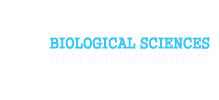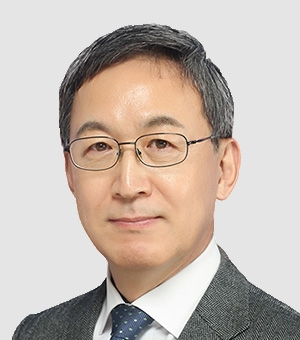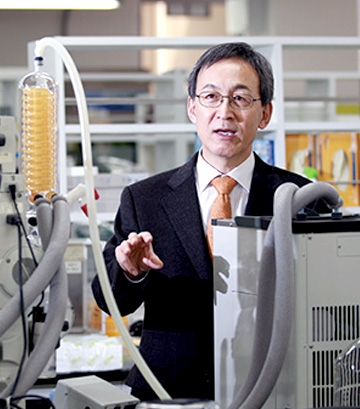Kim, Sunyoung
Analyzing how gene expression is regulated is one of the most important steps toward
to understanding the various phenomena of life. The main topics of our laboratory are to
study cell proliferation, differentiation, and related biological responses at the molecular
level, and when necessary, understand their implications in relation to various human
diseases. Our lab is also actively attempting to apply the data obtained from basic
research to the actual industry.
We are currently administrating two projects to develop new concept drugs for a variety of human diseases. One is gene therapy, and the other is to isolate therapeutically valuable biological response modifiers from herbs used in traditional oriental medicines. Although these two projects are seemingly different and distant to each other, they do share a common theme, which is to obtain therapeutic affects through the regulation of gene expression by using other genes or other chemical compound(s), in this case those that have been isolated from herbs. Furthermore, experimental techniques employed in these two projects are virtually identical.
(1) Gene medicine
Gene therapy is medical intervention based on genetic modification of living cells, either indirectly through an ex vivo approach or directly by applying the gene to the human subjects. One of the major limiting factors in this field is the lack of a gene delivery system that can efficiently and safely transfer the therapeutic gene to the body. We have recently developed improved gene delivery vehicles based on murine leukemia virus and naked DNA (plasmid) that are much superior to other existing systems. Using these tools, we have developed or are developing a variety of gene-based drugs that can be used for various life-threatening diseases. Our group played a significant role in carrying out Korea's first gene therapy clinical trial in the year 2001. Five clinical trials are planned in the US, Europe, China, and Korea over the next three years for genetic diseases, cancer and rheumatoid arthritis.
(2) Molecular herbal medicines
Another project is to isolate BRM from traditional herbs and develop them into new drugs. Although many therapeutically valuable herbs and formulations (consisting of multiple herbs) are available in Korea thanks to its rich history in the field, there has been very slow scientific progress. This is due mainly to a lack of understanding of modern science by oriental medicine physicians, underestimation of traditional herbal medicine by west-oriented molecular biologists and western medicine physicians, and a lack of cooperation between these two groups of people. We have secured a variety of herbal formulations that are unavailable to the public from the country's finest oriental medicine physicians and studied them at the molecular level as well as in the animal model and in vitro cell culture systems. A few recently obtained data include: a) water-soluble extract from an edible mushroom that highly activates transcription factor NF-kB and induces the differentiation of and proliferation of granulocyte lineage cells from the bone marrow; b) ethanol-extract from 12 different herbs that have strong anti-inflammatory and cartilage protective effects by regulating related cytokines and enzymes; c) water-soluble extract from an edible fruit at a specific growth stage that regulates Th2 response and has the potential for anti-atopic agents. As of February 2003, we are working on seven leading formulations.
Education
- - 1984.10 - 1986.8 D.Phil. : University of Oxford (U.K.), Molecular Genetics (Biochemistry Dept.)
- - 1982.9 - 1984.8 M.A. : Harvard University (Cambridge, MA, U.S.A.), Microbiology and Molecular Genetics
- - 1980.9 - 1982.8 M.S. : MIT (Cambridge, MA, U.S.A.), Biochemical Engineering
- - 1974.3 - 1978.2 B.S. : Seoul National University (Seoul, Korea), Microbiology
Career
- - 2011 - present President (R&D), ViroMed Co. Ltd. (Korea)
- - 2010 - 2011 Managing Director, Office of Strategic R&D Planning, Ministry of Knowledge Economy
- - 2006 - 2008 President , Korea Society of Gene Therapy
- - 2005 - 2010 Chief Executive Officer, Founder, ViroMed Co. Ltd. (Korea)
- - 2005 - 2006 Member, Presidential Advisory Council on Science and Technology
- - 2003 - 2008 Member of the Editorial Board for Gene Therapy (Nature Publishing Group)
- - 2001 - present Professor, School of Biological Sciences, Seoul National University
- - 2001 - 2008 Member of Scientific Advisory Group, International Vaccine Institute
- - 1999 - 2006 Director, Biotechnology Business Incubator,
- - 1998 - present Member of the Editorial Board for J. Gene Medicine (Wiley)
- - 1998 - 2005 Adjunct Member, Genethon III, France
- - 1996 - 2001 Associate Professor, Institute of Molecular Biology and Genetics, Seoul National University
- - 1996 - 1999 Adjunct Member, The Myles H. Thaler Center for AIDS and Human Retrovirus Research, University of Virginia, U.S.A.
- - 1992 - 1996 Assistant Professor, Seoul National University
- - 1990 - 1992 Assistant Professor of Medicine (Virology), Harvard University
- - 1989 - 1992 Research Staff (New England Deaconess Hospital, Boston)
- - 1989 - 1990 Instructor in Medicine, Harvard University
- - 1987 - 1989 Postdoctoral fellow, Whitehead Institute for Biomedical Research, and Department of Biology, MIT (with Dr. David Baltimore)
- - 1986 - 1987 Research fellow, Brigham and Woman
- Jyhyun Ahn, Jiwon Jang, Junsub Lee, Seo-ho Oh, Junghun Lee, Keejung Yoon, and Sunyoung Kim, 2014: GSK3β, but not GSK3α, inhibits the neuronal differentiation of neural progenitor cells as a downstream target of mTORC1. Stem Cells and Development, 23(10), 1121-1133.
- Doo Suk Lee, Jinyong Choi, Seon-Hee Kim, and Sunyoung Kim, 2014: Ameliorating effects of HX106N, a water-soluble botanical formulation, on Aβ25-35-induced memory impairment and oxidative stress in mice. Biol Pharm Bull., 37(6), 954-960.
- Jinyong Choi, Junsub Lee, Junghun Lee, Seon-Hee Kim, Jiyoung Kim, and Sunyoung Kim, 2013: PG201 downregulates the production of nitrite by upregulating heme oxygenase-1 expression through the control of phosphatidylinositol 3-kinase and NF-E2-related factor 2. Nitric Oxide, 33, 42-55.
- Donghyun Kim, Jinyong Choi, Mi-Jeong Kim, Seon Hee Kim, Sang Heon Cho, and Sunyoung Kim, 2013: Reconstitution of anti-allergic activities of PG102 derived from Actinidia arguta by combining synthetic chemical compounds. Experimental Biology and Medicine, 238, 631-640.
- Jiwon Jang, Jyhyun Ahn, Nayeon Lee, Seong-Tae Kim, Dae-Hyuk Kweon, Jae Youl Cho, Kye Won Park, Sunyoung Kim, and Keejung Yoon, 2013: Ultrasound Backscatter Microscopy Image-Guided Intraventricular Gene Delivery at Murine Embryonic Age 9.5 and 10.5 Produces Distinct Transgene Expression Patterns at the Adult Stage. Molecular Imaging, 1(12(8)), 485-90.



